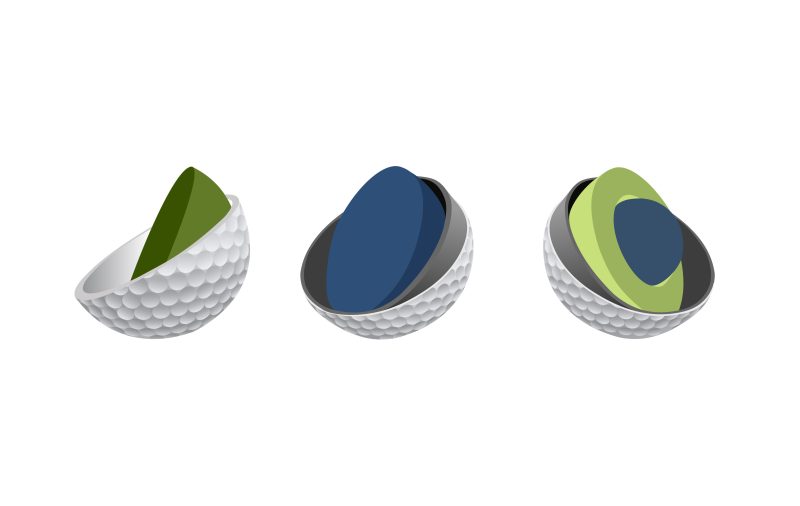Today, we’re diving into a topic that might sound technical but is crucial for every golfer: golf ball compression ratings. Have you ever wondered why some balls feel softer when you hit them while others seem to spring off the clubface? It’s all about compression, and understanding it can be a game-changer for your performance on the course.
Golf requires precision and skill, and the gear you use can greatly affect how well you play. Like selecting the right clubs, choosing the right golf ball is vital.
But with so many options on the market, how do you decide? That’s where golf ball compression ratings come into play.
Whether you play golf occasionally for fun or aspire to become a professional, understanding and mastering this aspect of your equipment can help you reach your full potential and make the game more enjoyable. So, let’s dive into the golf ball compression world and discover how this little number can make a big difference in your game.

What is Golf Ball Compression?
Simply put, golf ball compression refers to how much a golf ball deforms or compresses upon impact with the club. It measures the ball’s firmness and is expressed as a number – typically ranging from low (below 70) to high (above 100). But what does this number mean for you and your game?
Imagine golf ball compression like a spring. A high-compression ball (100 and above) is like a stiff spring; it requires more compression force and is generally preferred by players with faster swing speeds. These balls tend to give less of a ‘squishy’ feel and more of a ‘solid’ feel. Conversely, low compression balls (below 70) are like softer springs. They compress more easily, making them ideal for players with slower swing speeds, providing a softer feel and helping to maximize distance.
Between these two extremes are medium compression balls, designed to suit a broad range of players who have moderate swing speeds. These balls balance distance and control, offering a versatile option for many golfers.
Understanding golf ball compression is crucial because it directly affects your shots’ distance, trajectory, and feel. Selecting a ball with the right compression rating for your swing can make a noticeable difference in your game. It’s not just about how hard or soft the ball feels but how well it matches your playing style and swing mechanics.

The Science Behind Compression
Let’s get a bit scientific, but don’t worry, I’ll keep it light and easy to understand. The magic of golf ball compression lies in its impact on ball flight and performance. When you strike a golf ball, the force of your swing makes the ball compress and then rebound. This rebound is what sends the ball soaring through the air.
The materials used in making golf balls play a significant role here. Modern golf balls typically have a core made from synthetic rubber, which is key to determining the ball’s compression.
The firmer the core, the higher the compression rating. Higher compression balls tend to produce less spin and more distance, making them a favorite among players with powerful swings. Conversely, lower compression balls have more spin and provide better control, which can be a boon for players with slower swings.
So, in a nutshell, the right compression works with your swing to optimize the ball’s performance, affecting how far and how straight it travels.

Choosing the Right Compression for Your Game
Choosing the right compression isn’t a one-size-fits-all scenario. It’s more like finding the perfect pair of shoes to fit your style and comfort. Generally, a higher compression ball can maximize your distance if your swing speed is fast (think pro-level speeds). For those with a slower swing (which is most recreational players), a lower compression ball can help you get more distance.
Here’s a pro tip: Don’t shy away from experimenting. Many golfers, especially beginners and intermediates, overlook the importance of ball selection. But just like you would try different clubs to see what works best, doing the same with golf balls can significantly improve your game. Visit a local pro shop; they might just have a variety of balls you can test out.
Remember, the goal is to find a ball that feels good when you hit it and performs well with your typical swing.
The Role of Weather and Conditions
Golf isn’t played in a lab – it’s played in the real world, where weather and playing conditions vary. Believe it or not, these factors can influence your golf ball’s behavior. For instance, a golf ball tends to compress less in colder weather, affecting its distance and feel. This is why some golfers prefer a lower compression ball in colder climates – it helps offset the reduced compression caused by the temperature.
Similarly, playing at higher altitudes or humid conditions can affect ball flight and performance. The key is to be aware of these factors and adjust your equipment and play style accordingly. Sometimes, the difference between a good round and a great one is just a matter of understanding and adapting to the environment you’re playing in.

Popular Golf Ball Brands and Their Compression Ratings
When exploring golf ball compression, looking at what’s on the market is helpful. Major brands like TaylorMade, Titleist, and Callaway, among others, offer a variety of golf balls with different compression ratings. For instance, TaylorMade’s Tour balls are typically high compression, designed for golfers with faster swings. On the other hand, their Soft Response line caters to those seeking lower compression for a softer feel and more flexibility.
Exploring different brands can give you a sense of the range of options available. Every brand has its own special technology and design principles that affect the compression and overall performance of their golf balls. It’s not just about the brand name; it’s about finding a ball that aligns with your swing and game style.
Myths and Misconceptions
There are plenty of myths surrounding golf ball compression. One common misconception is that high-compression balls are categorically ‘better’ or ‘go farther’ than low-compression balls. This isn’t necessarily true. The ‘best’ ball depends more on how the ball’s compression aligns with your swing speed and style.
Another myth is that you need to be a professional or a highly skilled amateur to benefit from understanding and choosing golf ball compression. This couldn’t be further from the truth. Golfers at all skill levels can see noticeable improvements in their game by selecting the right compression rating for their balls.
Understanding these misconceptions helps make more informed choices about the golf balls you use, leading to a better and more enjoyable golfing experience.
How to Test and Find Your Ideal Ball
Finding your ideal golf ball might sound daunting, but it’s pretty straightforward. Start by testing different compression ratings. Many golf shops offer trial packs or can recommend a variety of balls to try. Pay attention to how each ball feels when you hit it and observe its performance – does it travel the distance you expect? Does it feel good coming off the clubface?
Also, consider getting a professional fitting. Just like clubs, golf balls can be fitted to your game. A professional can analyze your swing speed and style, offering tailored recommendations. This can be particularly useful if you’re serious about improving your game or struggling to decide between a few options.
Experimentation and professional advice are key. Finding your perfect match might take a few rounds, but once you do, it can make a significant difference in your game.
Impact of Golf Ball Compression on Your Overall Game
The choice of golf ball compression has a more significant impact on your game than you might think. For starters, the right compression can enhance your driving distance. If you’re using a ball that’s too high in compression for your swing speed, you won’t be able to compress it fully, resulting in shorter drives. Conversely, a ball that’s too low in compression for your swing might not offer the optimal energy transfer, leading to a loss of distance.
Beyond distance, compression affects your feel and control over the ball, especially in your short game. Lower compression balls typically offer better control, making them ideal for shots around the green. This can be a game-changer for golfers who value precision over distance.
Ultimately, the best way to understand the impact is through personal experience. Pay attention to how different balls affect your game in various areas – driving, approach shots, putting – and you’ll start to see patterns that will guide your choice.
Conclusion
We’ve covered a lot of ground in our exploration of golf ball compression, from understanding what compression is to how it affects your game and even debunking some common myths. Remember, the key takeaway is that there’s no one-size-fits-all answer. The best golf ball depends on your unique swing and playing style.
Golf is as much about the small details as the big swings. Paying attention to aspects like ball compression can lead to noticeable improvements in your game. Whether you’re a weekend player or on the path to becoming a seasoned pro, taking the time to understand and select the right golf ball is worth the effort.
